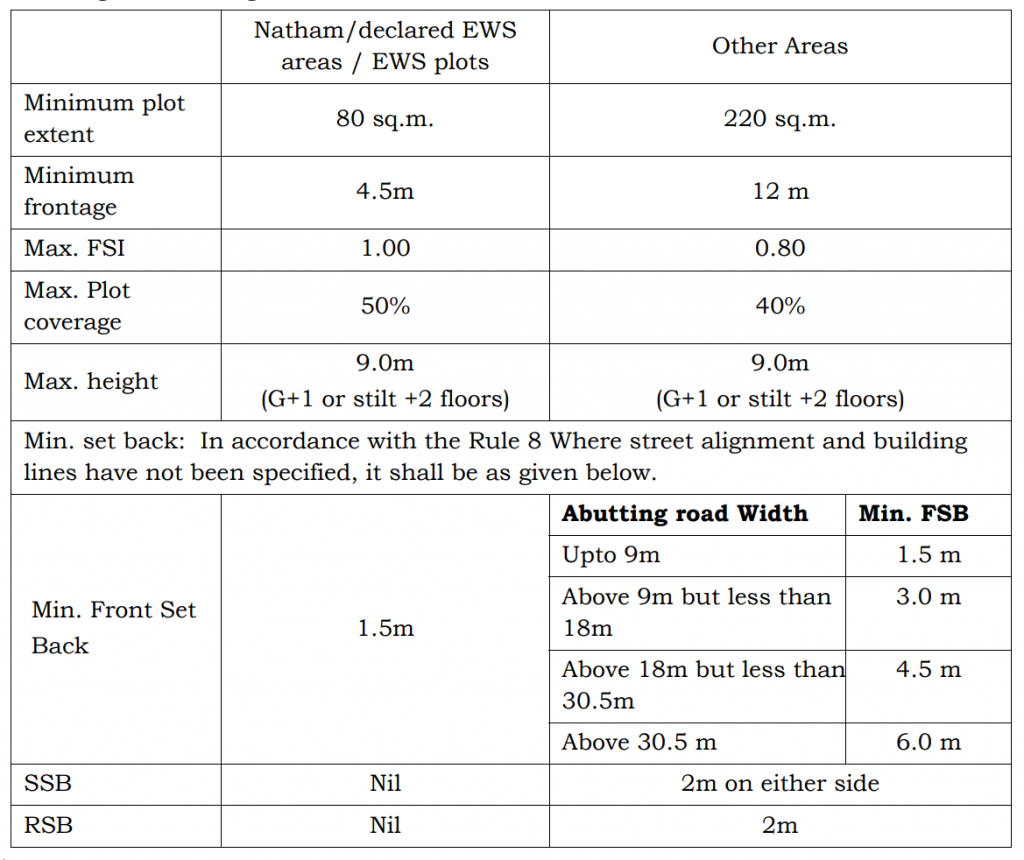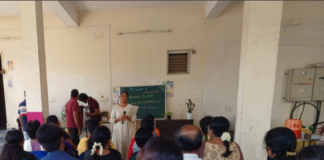Chennai water crisis is all across the internet to the point it is compared to Day 0 of Capetown. In a way it did bring everybody’s attention to the severity and the collaborative effort needed by the citizens to manage the situation.
This article aims at understanding what does the building law say about water management. We we amused to notice that many building would technically be under gross violation. So “Dear Chennai Citizens” Before you point fingers at the Government, Chennai if your property complies to the Law!
Are you Partner to the Water Crisis in Chennai?
The Municipal Administration and Water Supply department recently notified the Tamil Nadu Combined Development and Building Rules, 2019. This has been done in concurrence with the Housing and Development Department.
Sporadic weather has caused Chennai to now have severe water related stress events. 2015 was year of extensive rain, 2016 was year of cyclone and 2017 had no significant water event. 2018 officially is a water deficit year.
Building Development Rules that Protect our Water
The Tamilnadu Combined Development Rules, 2019 has built on previous regulations to protect the rain season dependent city of Chennai.
Building in Close Proximity to a Water Body
Every person, who constructs, reconstructs, or alters or add a building shall whenever the site is within 15 meters of any tank, reservoir, watercourse, river, fresh water channel or well, carryout such measure as may be necessary or as the executive authority may direct, for the purpose of preventing any contamination of or any risk of the drainage of building passing into, such tank, reservoir, water-course, river, fresh water channel or well such other rules in force.
The law mandates that all structures must have rain water harvesting structures.
Now, this is very interesting indeed! Considering the fact that Chennai Metropolitan Area has more than 1400 water bodies including the 420 within the Chennai Municipal Corporation Area. If a safe buffer of 100m are drawn from every water body then most of Chennai would be strictly controlled by this definition.
Rain Water Harvesting
The compulsory rain water harvesting law enacted during the Chief Ministership of Selvi Jayalalitha, significantly improved the ground water table of the city.
The law regarding, Rain Water Harvesting states that: Effective measures shall be taken within each premises (roof top and campus) for conservation of rainwater, and RWH structures to the following standards shall be provided; the same shall be shown in the plan applied for planning permission.
Non High Rise Buildings – Buildings of height up to 12m
Following are the recommended designs that can be adopted in the non High Rise Buildings ie., Independent Houses and Apartments with Ground + two floor or Stilt 3 floors and not more than 16 dwelling units). In plots that are being developed/buildings with a dug (source) well, rooftop
water to be diverted to a sump for immediate use (if that is relevant), through a first flush cum pebble-sand filter combination or a Special filter and the overflow to be diverted to the source well. The rain falling on the driveway or paved setback areas (around campus) and from rooftop pipes that are not connected to the sump or source well to be intercepted near the gate(s) either by means of a gutter (provided with a perforated lid) or a bump/speed breaker arrangement and led to a recharge well. (Drawing 1A & 1D).
In plots to be developed/buildings without an open well, rooftop water to be diverted to a sump for immediate use (if that is relevant), through a first flush cum pebble-sand filter combination or a Special filter and the overflow to be diverted to a recharge well. The rain falling on the driveway or paved setback areas and from rooftop pipes that are not connected to the sump or recharge well to be intercepted near the gate(s) either by means of a gutter (provided with a perforated lid) or a bump/speed breaker arrangement and led to a recharge well. ( Drawing 1B & 1D)
In plots to be developed/buildings where the setback area is very small, not
enough to dig a recharge well or sewers, water line, electrical cable running
below, rooftop water brought down by pipes should be led to percolation pits, one per pipe. (Drawing 1C)

Non High Rise Buildings more than 12m height and upto 18.3m height and Industries and Institutional Buildings
In case of Non High Rise developments, Industries, Institutional Buildings as mentioned in all the above cases, rooftop water can be diverted to a sump for immediate use (if that is relevant), through a first flush cum pebble-sand filter combination or a Special filter that is available in the market and the overflow to be diverted to either a dug (source) well or a recharge well depending on the availability of a source well. Depending on the need and relevance any combination of the above methods can be chosen.
In the above mentioned categories, rain falling on the setback areas as well as some of the rooftops will flow on the driveway itself and runoff to the streets and get wasted. This runoff should be intercepted by means of a bump/speed breaker arrangement constructed in one or more locations within the premises and discharged into suitably designed recharge well (s) located nearby. (Drawing 3A.)
Rain falling on the setback areas as well as some of the rooftops will flow into the storm drains constructed along the periphery of the building, whose slope will always be towards the gate(s) in order to discharge the runoff onto the street. This flow within the drain can be intercepted inside the drain by a baffle wall and injected into several recharge wells located close to the drain. (Drawing 3B.)
High Rise Buildings (Residential/Commercial)
In plots that are being developed/buildings with a source well, rooftop water to be diverted to a sump for immediate use (if that is relevant), through a first flush cum pebble-sand filter combination or an Special filter that is available in the market and the overflow to be diverted to the source well. The rain falling on the driveway or paved setback areas or from rooftop pipes not connected to the sump or source well to be intercepted near the gate(s) either by means of a gutter (provided with a perforated lid) or a bump and led to a recharge well. ( Drawing 2A & 2D)
In plots to be developed/buildings without an open well, rooftop water to be diverted to a sump for immediate use (if that is relevant), through a first flush cum pebble-sand filter combination or a Special filter that is available in the market and the overflow to be diverted to a recharge well. The rain falling on the driveway, paved setback areas, and from rooftop pipes that are not connected to the sump or recharge well to be intercepted near the gate(s) either by means of a gutter (provided with a perforated lid) or a bump/speed breaker arrangement and led to a recharge well. (Drawing 2B, 2C & 2D)
Additionally, Within the site major part of the area which is not covered
by the buildings / structures shall not be paved and it shall be maintained as green space with proper rain water harvesting provisions allowing the storm water collected during precipitation percolates below and recharge the aquifer.
Any direction / instruction given by the approving authority in the matter of preservation of the aquifer recharge shall be carried out by the applicant, land owners, buyers, developers. If any direction / instruction is not carried out, action may be taken by the approving authorities to carry out the work and the expenditure incurred for that work shall be collected from those who failed to carry out the direction / instruction as if it is an arrear of land revenue by the authority concerned or by the Taluk Tahsildar.
Any failure to carry out the direction / instruction or fulfill the condition shall be the sufficient ground for ordering for discontinuance of the activity in the premises.
Storm Water Drainage
Storm water drainage system in a site shall be designed in such a way to harvest cent percent of it to recharge ground water table below. The design factors of rain water harvesting structures within a site shall include type of soil and its absorption capacity, ground slope, intensity and duration of rain fall for the design period etc. However there shall also be a provision for carrying any excess storm water which was not absorbed during an exceptional rain fall, to drain or discharge into the street or public storm water drainage system.
No existing natural or man-made drainage system such as channel, canal, nallah etc. passing through the site shall be closed. When it is realigned within the site optimizing the usability of the site, due care shall be taken that its carrying capacity or velocity of flow is not reduced affecting the upstream and downstream sites and such a realignment shall be done only with prior approval of the Executive Authority of the Local body.
Special Regulation for Aquifer Recharge Area
High Rise Buildings are permissible in the Chennai Metropolitan Area excluding the following areas: –
- Area bounded by two arms of Cooum river starting near Park Station to the mouth of Cooum river (Napier Bridge) generally known as Island Grounds.
- Aquifer Recharge Area bounded in: the North by Thiruvanmiyur Village, the East by Bay of Bengal, the West by Buckingham Canal, the South by Chennai Metropolitan Area boundary
- Redhills Catchments Area stated in the regulation no. 24 (2) (c)
Redhills and Puzhal lakes are the main sources of water supply to the Chennai city. In order to protect this water source from the negative impacts of the urban developments contiguous areas in the catchments of these lakes has been declared as ‘Redhills catchments area’. The description of the catchments area and regulations for development therein is given in Appendix -B.
This is relevant since most of the buildings in Thiruvanmiyur in Chennai are more than 18.3 meters. All the Sea Ward Roads, Kotivakkam RTO Section, you can see many flats beyond this height. We are curious to know if our interpretation of the law is indeed correct. Because such gross violation of building laws cannot have gone un-noticed. can comebody clarify to us in the comments section.
Regulation for developments in the Aquifer Recharge Area
- In the interest of maintaining the aquifers in the area and to realise the full benefits of recharge into this aquifer during precipitation, this aquifer recharge area that serve as one of the major sources for city water supply has been declared as aquifer recharge area restricted for development. Details of villages covered in the aquifer recharge area are given in Map no MP-II/CMDA.10/2008 and it is bounded by city limits in the north, CMA limits in the south, B’canal in the west and coastal line in the east falling in the following villages: Kottivakkam, Palavakkam, Neelankarai, Okkiamthuraipakkam, Injambakkam, Karapakkam, Sholinganallur, Uthandi
- Parts of the Restricted Development Zone area to a depth of 500 m from the High Tide Line of the sea and 100 m from the Buckingham canal lie in the Coastal Regulation Zone as per the Coastal Zone eanagement Plan. Developments there in shall also be subject to the Coastal Zone Regulation notified by Government of India under the Environment (Protection) Act, 1986 and the amendments made from time to time.
- In the Restricted Development Zone, Non High Rise upto 9m height with 6 dwelling units residential and commercial buildings, Institutional and other non High rise building shall be permitted only for the following purposes and accessory uses.
Permissible Deveopments.
- Any Non High Rise upto 9m height with 6 dwelling units residential building including dwelling, detached, semi-detached, tenements or flats and service apartments.
- Professional consulting offices and incidental uses thereto occupying a floor area not exceeding 40 sq.m. and G+1 floors in height
- Schools of Commerce including Tutorial Institutions not exceeding 100 sq.m in floor area and G+1 floors in height
- Petty shops dealing with daily essentials like retail sale of provisions, soft drinks, etc., tea stalls, bakery, confectionary, retail shops, mutton stalls, milk kiosk, cycle repair shops, tailoring shops etc. occupying a floor area not exceeding 40 sq.m. and G+1 floors in height
- Nursery schools, Primary Schools, High Schools, Higher Secondary Schools, Libraries and reading rooms.
- Parks, play grounds, farms, gardens, nurseries, including incidental buildings thereon
- Cottage industries listed in Annexure – V (with number of workers not exceeding 8 and electric machineries not exceeding 5 H.P.) with G+1 floors in height
- Storage of domestic cooking gas cylinders not exceeding 300 M2 in floor area subject to the conditions prescribed in G.O.M.sNo.329 dated 24.2.1977 viz. necessary the Applicant should obtain clearance from the Director of Fire & Rescue Services and from the Dept. of Explosives of the Govt. of India.
- Hostels and dormitories not exceeding 500 sq.m. in floor area and G+1 floors in height
- Working women’s hostel / old age homes with G+1 floors in height
- Assembly halls, welfare institutions not exceeding 300m2 in floor area and 18.30m in height (upto crown level in case of leaned roofs).
- Govt./Semi Govt. Offices, Banks, Pay Offices, Post Office, Offices of Electricity Board, Tamil Nadu Cooperative Milk Producers Federation Limited, etc. occupying a floor area not exceeding 300 sq.m. and G+1 floors in height
- Daily or weekly markets serving local needs not exceeding G+1 floors.
- Transport depots. bus terminals and railway stations.
- Service industries serving the local needs such as flourmills, repair shops, service workshops with installations not exceeding 15 HP, 300m2 in floor area and G+1 floor in height.
- Public Utility Buildings like sewage-pumping stations, water works, Fire stations, Telephone exchanges not exceeding 18.30m in height.
- Restaurants not exceeding 300 sq.m. in floor area with G+1 floors in height provided the width of the abutting road is minimum 10 metres
- Clinics, Nursing Homes, Dispensaries and other Health facilities not exceeding 300 sq.m. in floor area with G+1 floors in height provided the width of the abutting road is minimum 10 metres
- Departmental stores with a floor area not exceeding 100 Sq.m and with G+1 floors in height provided the width of the abutting road is minimum 10 metres
- Fuel filling stations and service stations with installations not exceeding 5 HP and with G+1 floors in height provided the width of the abutting road is minimum 10 metres
- Swimming Pools attached to residential activity in a plot.
- Air-conditioned Cinema Theatres and open-air theatres not exceeding 18.30m in height abutting min. 12 m wide road.
- Burning burial grounds, crematoria and cemeteries.
- Religious buildings not exceeding 300 sq.m. in floor area
- On plots/sites not less than 1 Hect. in extent:
- Beach cottages, hotels and tourism-based developments as may be decided by the Authority not exceeding 18.30m in height.
- Recreational activities not exceeding 18.30m. in height
- Educational, technical and research institutions not exceeding 18.30 in height
In the Natham sites, and the sites shown as EWS Area in the Master Plan Map the activities listed as A(i) to (viii) and B(i) to (xii) are only permissible. In other areas, all the activities listed in (3)A and (3)B are permissible. Permissible non-residential activity shall be limited to one in a subdivision plot in cases where it is a residential plot in an approved layout.
The extent of the site, plot coverage, FSI, Set back, etc. for the developments shall be regulated as given below:
Non High Rise Buildings upto 9m height Residential / Commercial Buildings and Other Small developments:
- Non High Rise building upto 9m heigt residential / predominantly residential, clinics, Dispensaries, Nursing homes stated above
- Working women hostels stated above
- Service apartments stated above
- Cottage industries (with number of workers not exceeding 8 and electric machineries not exceeding 5 H.P.) stated above
- Nursery schools, primary schools not exceeding 300 sq.m.
- Reading rooms, libraries, post office, EB office, telegraphic office, Local body maintenance offices not exceeding 300 sq.m.
- Govt., semi Govt. office stated above
- Religious building stated above

Other parameters such as Parking, width of corridor etc shall be regulated as provided elsewhere in these rules. For New Sub-divisions and layouts, plot extent and frontage shall be minimum as prescribed above. In cases of earlier approved layout plots or approved sites, it shall be as per the approved layout plan or approved site plan and no further sub division shall be allowed or recognized after the date of coming into force of these rule unless it satisfies the regulations applicable for development in Restricted Development Zone. Further even in such approved layout plots or approved sites construction for which permissions sought shall comply with these rules applicable for developments in RDZ.
In the rear set back of residential premises structures like lavatory, lumber room, garage, etc. not intended for human habitation and servant quarters may be permitted provided that such structures do not occupy more than one-third of the rear width of the site and 6 m from the rear boundary; provided further that the height of such structures do not exceed 4 m measured from the ground level of the site.
Other large institutional developments such as Religious Buildings, Higher Educational, Technical and Research Institutions shall be regulated wit reference to the planning parameters given in rule 37 subject to a maximum FSI of 0.80 and maximum plot coverage of 40%. Assembly halls and other assembly buildings /places of public assembly shall have minimum set back of 6m all around.
Service industries stated in (3) (xiv) above shall be regulated with reference to the planning parameters given in rule 36 subject to maximum FSI of 0.80 and maximum plot coverage of 40 %. Beach cottages, hotels, tourism based developments and recreational activities stated in sub rule (3) (xxv) (a) and (b) and also daily or weekly markets and other commercial activities stated above shall be regulated with reference to planning parameters given in rule 35, subject to a maximum FSI of 0.80 and maximum plot coverage of 40%.
The laying out and sub division / amalgamation/reconstitution of land for building purposes shall be carried out in accordance with the provisions specified in rule 47 subject to minimum plot extent and frontage as specified above. No new subdivision or layout shall obstruct the access to beach by general public and the developers shall provide access of adequate width to beach when such developments are made:
Rain water harvesting – (a) Within the site major part of the area which is not covered by the buildings / structures shall not be paved and it shall be maintained as green space with proper rain water harvesting provisions allowing the storm water collected during precipitation percolates below and recharge the aquifer. (b) Any direction / instruction given by the approving authority in the matter of preservation of the aquifer recharge shall be carried out by the applicant, land owners, buyers, developers. If any direction / instruction is not carried out, action may be taken by the approving authorities to carry out the work and the expenditure incurred for that work shall be collected from those who failed to carry out the direction / instruction as if it is an arrear of land revenue by the authority
concerned or by the Taluk Tahsildar. (c) Any failure to carry out the direction / instruction or fulfill the condition shall be the sufficient ground for ordering for discontinuance of the activity in the premises. The sewage disposal system within the premises shall be so designed not to pollute the
aquifer.
Regulations for Redhills catchment area
The Redhills Catchment is declared restricted for development due to the benefits of surface run off during precipitation.
Details of the villages covered under the catchment area are given in the Map No. MP-II/CMDA.11/2008 and the villages list is given below: Attanthangal, Pammadukulam, Pothur, Vellanur, Morai, Pulikutti, Tenambakkam, Arakkambakkam, Pandeswaram, Melpakkam, Kadavur, Karlambakkam, Kilkondaiyur, Alathur, Vellacheri, Pakkam , Palavedu, Mittanamallee, Muktha pudupattu, Kovil padagai, Vijayanallur, Palaya, Erumaivetti palayam, Alamadi, Thirumullaivoyal (Part) – (All S.Nos. north of M.T.H. Road), Nallur (Part) – (Serial Numbers West of G.N.T. Road), Oragadam (Part) – (S.Nos. north of Ambattur Redhills Road), Padianallur (Part) – (All west of G.N.T. Road)
In the areas zoned as Primary Residential , Mixed Residential , Industrial (covering the existing industries of National importance). Additionally the areas covered in approved layouts, and areas reserved for commercial exploitation within 122 m. (400 ft.) wide ORR, developments are allowable subject to satisfying zoning regulations and planning parameters prescribed in these rules.
Other use zone classifications such as commercial, Institutional etc have not been made in these villages specifically for prohibition of such activities in this catchment area. Existing authorised activities may continue without expansion or enlargement.
Contiguous Government lands in these areas are deemed to have been zoned for Open space and Recreational use for developing social forestry. No lands shall be reclassified into any urban use zone.



